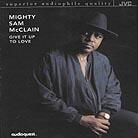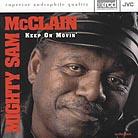October 1999
McClain's first two albums for AudioQuest, Give It Up To Love and Keep On Movin’, were musical powerhouses. In original release, they also stood as sonic references. So when JVC began their XRCD program (Extended Resolution CD), many, myself included, were surprised to see both these in the initial wave. Personally, I was impressed by the decision. Since the XRCD market, due to cost alone, would primarily be audiophiles, chances were good that prospective buyers would already have one of these discs. And if they had one, chances were good they were already using it as a reference. And if, after shelling out $30-$35 for the XRCD, the remaster failed to impress, the whole program would go down. So how do these discs sound? Let’s talk about why JVC had confidence in XRCD first. Unlike HDCD, SBM, UV22 or countless others, XRCD is not a mastering process alone. Rather, starting with the master analog feed, JVC creates a 20-bit digital master using their K2 super coding process, which, according to JVC, has extremely low intrinsic jitter. Then, instead of saving to the industry standard U-matic 1630 tape, the 20-bit master is transferred to a Sony PCM-9000, where is it stored on a magneto-optical disk. That disk is then sent to Yokohama where the real magic of the XRCD process takes place. There, a special down-conversion feature of the K2 process is used to create the 16-bit master. This process, according to JVC, keeps 20-bit resolution without the use of noise shaping. The 16-bit master is then EFM encoded. Finally, the EFM’ed data undergoes a final "reshape" immediately before going to the cutting laser. This step purportedly eliminates all time-based jitter. All these processes take place in a controlled, clean-room environment using SPIF-2 data pathways for all connections and with regulated and isolated AC power. This level of attention to the mastering and cutting chains is what sets XRCD apart from other ultra-fi techniques. So how does the process sound? In a word, better. These XRCDs have a lower noise floor, deeper and wider staging, a cleaner and yet more explosive top end, tighter bass and a bit more textural resolution than the original issues. And this is in comparison to discs that just two or three years earlier were sonic references. In all, this makes the XRCD versions of these albums the ones to get. And you really should get these albums. If you haven’t heard them, Mighty Sam lays down a powerful brand of medicine. The overall feel is of classy but still downtown soul, backed up with the pain of the blues, with a bit of gospel teaching thrown in for good measure. If McClain sounds like anyone, it would be Al Green’s first cousin from about 100 miles further south, spiced with a dash of Bobby "Blue" Bland. In fact, on each of these albums McClain covers a Green tune ("Lord Will Make a Way" on Movin’ and "I Feel Good" on Love). With organ on most tracks, a deep soul feel is at the center of these albums. Qualitatively, choosing between the two is more a matter of what’s in stock. Love has a bluesier groove, with a great slow-burn version of Carlene Carter’s "Too Proud," the aforementioned Green tune and nine originals. Movin’ offers a Green tune, a Ronnie Earl song, nine originals and a more upbeat sound. My preference is for the first, but then I’m a bit more down and dirty than I am upright and sanctified. Either way, the music is a winner. GO BACK TO: |
 Mighty Sam McClain - Give
it Up to Love
Mighty Sam McClain - Give
it Up to Love Remastered
Remastered![[Reviewed on Gold CD]](../format/regcd.gif) It may be cliché, but
it’s seldom wrong to invoke Holt’s Law (recording quality is inversely
proportional to musical quality) in reference to "audiophile" recordings. There
are, however, exceptions, with the AudioQuest label consistently violating the rule. Doug
MacLeod, Bruce Katz, Bennie Wallace, and Ronnie Earl have all turned out superb
blues-based albums for the label. But even their excellent work takes a backseat to that
of Mighty Sam McClain.
It may be cliché, but
it’s seldom wrong to invoke Holt’s Law (recording quality is inversely
proportional to musical quality) in reference to "audiophile" recordings. There
are, however, exceptions, with the AudioQuest label consistently violating the rule. Doug
MacLeod, Bruce Katz, Bennie Wallace, and Ronnie Earl have all turned out superb
blues-based albums for the label. But even their excellent work takes a backseat to that
of Mighty Sam McClain.